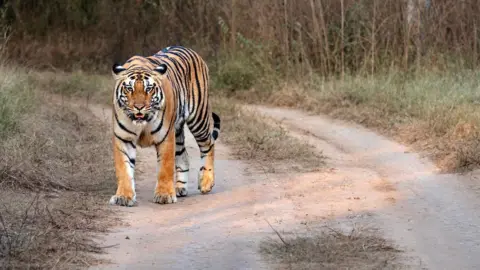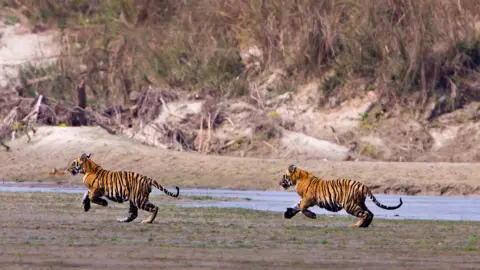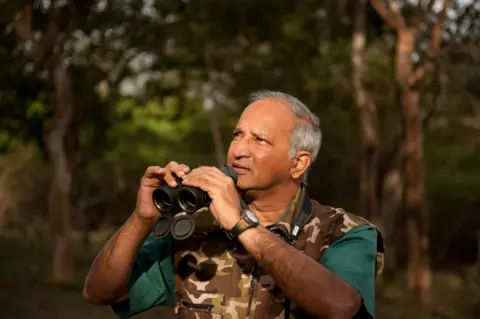[ad_1]
 Getty Pictures
Getty PicturesNepal has been celebrated globally for tripling its tiger inhabitants in a decade – however Prime Minister KP Sharma Oli thinks the nation could have been too profitable.
“In such a small nation, we’ve got greater than 350 tigers… We won’t have so many tigers and allow them to eat up people,” he mentioned final month at an occasion organised to overview the nation’s COP29 outcomes.
Assaults by tigers claimed practically 40 lives and injured 15 folks between 2019 and 2023, in line with authorities knowledge. However native communities say the determine is far increased.
“For us, 150 tigers are sufficient,” Oli declared in December, even suggesting that Nepal might ship its prized massive cats to different international locations as presents.
What number of tigers are too many?
There isn’t a one reply, consultants say. It depends upon the provision of prey in a given space – ideally, every tiger ought to be within the neighborhood of about 500 prey animals, similar to deer, antelopes or wild buffalo, tiger biologist Ullas Karanth says.
Specialists argue that Oli’s concern with capping tiger numbers is misplaced. Somewhat, Nepal’s authorities ought to give attention to “increasing protected areas which have affordable pure densities of prey and tigers,” Dr Karanth provides.
If wildlife is spilling out of protected areas in quest of prey, which may clarify why so many assaults have occurred in locations that border forests, the place tigers have all the time encountered people.
An instance is the “buffer zones” that lie between nationwide parks and human settlements. Wildlife sightings are frequent right here, however locals additionally use the world for cattle-grazing and gathering fodder and firewood.
Forest corridors – strips of land that join totally different parks and bio-reserves permitting wildlife to roam between them – have emerged as yet one more flashpoint. Roads generally run via these areas, and locals additionally use them for foraging, leaving them weak to assaults.
The rise in human fatalities is an indication that Nepal’s once-successful conservation mannequin is cracking, zoologist Karan Shah says.
 Getty Pictures
Getty Pictures“Up to now, [Nepal’s] focus appears to be on successful worldwide consideration, whereas ignoring the affect on communities dwelling round nationwide parks and guarded areas,” Mr Shah provides.
He argues that conservation isn’t just “an ecological or scientific challenge” but additionally a social one – and that the lack of human lives have to be prevented so native communities stay part of the conservation effort and do not flip towards it. Anger amongst locals has additionally been rising as tigers have been preying on livestock.
“A good portion of our inhabitants nonetheless stay in rural areas and are depending on forest assets that they assist preserve – however they’re now more and more being killed and injured by tigers,” Thakur Bhandari, president of Federation of Group Forestry Customers Nepal, instructed the PJDM.
“As forest conservationists we can’t be towards wildlife, however that doesn’t imply we must always ignore its affect on people and our society.”
Successful story turned lethal
A century in the past, some 100,000 tigers roamed Asia – however deforestation and rampant poaching pushed them to the brink of extinction. There at the moment are solely about 5,600 wild tigers remaining throughout 13 international locations, together with Nepal, China, India, Thailand, Indonesia and Russia.
All of those nations had dedicated to doubling their tiger numbers by 2022, however Nepal was the primary to surpass the goal – due partially to a zero-poaching initiative and a doubling of the nation’s forest cowl between 1992 and 2016.
Connecting 16 protected zones in southern Nepal with areas throughout the border in northern India created forest corridors which helped too.
The rising variety of tiger assaults has now tarnished that achievement.
Oli believes Nepal’s tiger inhabitants is rising at the price of human lives. Viable options, nevertheless, will not be straightforward to come back by.
The parks and wildlife division has acknowledged the problem of managing tigers in Nepal, the place those who kill people are tracked down and brought into captivity.
“Zoos and rescue centres are already overwhelmed with problematic tigers,” the division mentioned in a conservation report revealed in 2023. “A complete protocol is urgently wanted to deal with the rescue, dealing with, and rehabilitation of drawback animals.”
 Ullas Karanth
Ullas KaranthOli has proposed sending Nepal’s tigers overseas.
“Folks like to preserve birds like falcons and peacocks as pets, so why not tigers?” he advised. “That might enhance their standing too.”
Others have totally different concepts.
Dr Karanth says tigers which have repeatedly taken human lives ought to be “killed instantly”. Some argue that people exacerbated the issue by encroaching into the tigers’ pure habitats, utilizing the land for cultivation or infrastructure and decreasing the massive cats’ prey-base.
The PJDM spoke to a wildlife administration skilled, in the meantime, who claims Oli desires to carry down tiger numbers in order that extra land may be cleared to construct infrastructure.
“It isn’t about folks’s security,” he mentioned.
For now the state of affairs is at an deadlock. It is unclear whether or not Oli’s “tiger diplomacy” suggestion will achieve traction, or whether or not over-encroaching people or tigers are responsible for Nepal’s tiger assault disaster.
What is obvious is that people and tigers are struggling to realize peaceable co-existence in Nepal – and the nation’s conservation success story has introduced a lot of its personal thorny issues to reckon with.
[ad_2]
[ad_1]
#Nepals #chief #tigers
[ad_2]
, 2025-01-16 23:05:00


